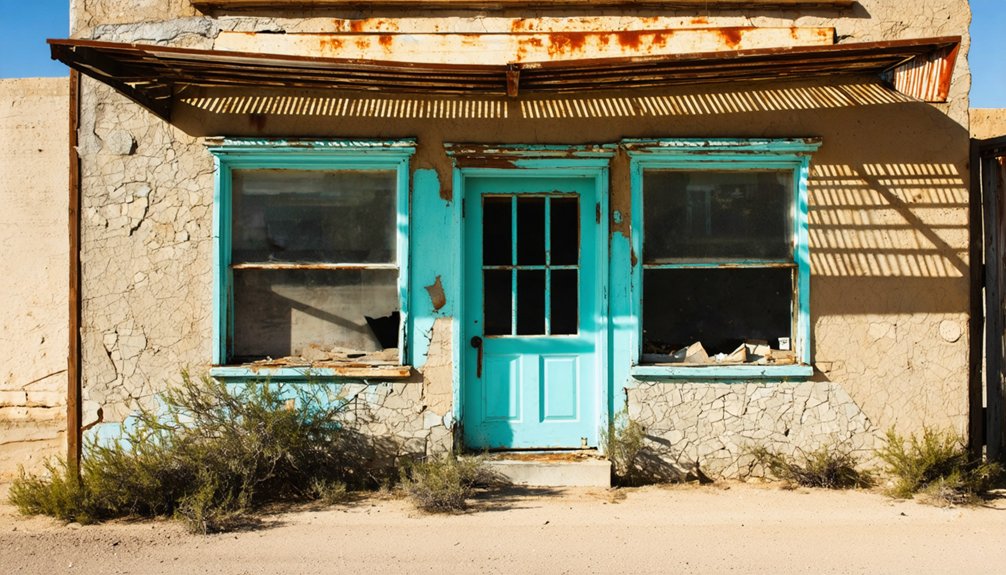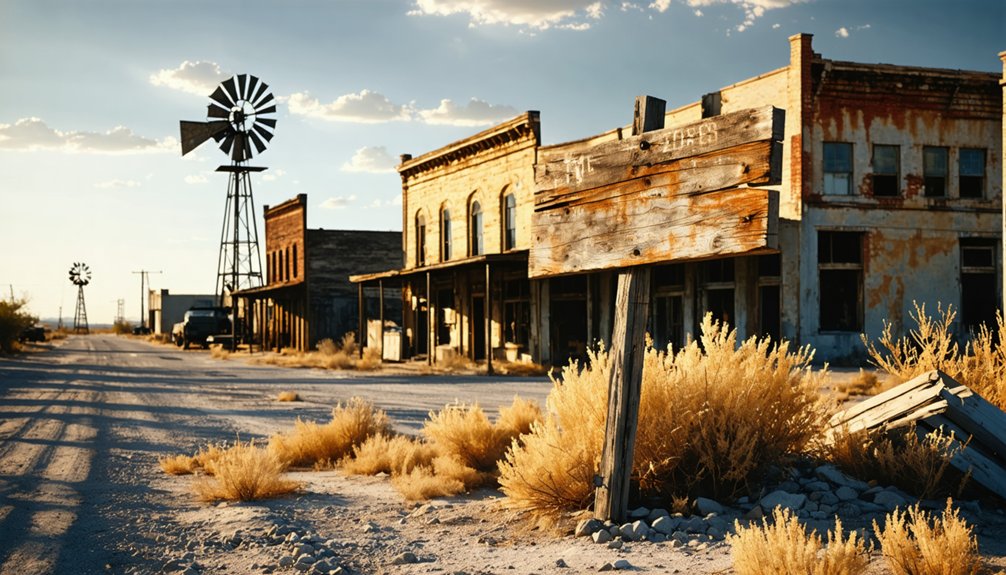You’ll find Orla, Texas in northwestern Reeves County, a striking example of the oil industry’s boom-and-bust cycle. Founded in 1890 as a railroad section house, it grew from 10 residents in 1933 to 250 during the 1960s oil boom. Today, only two residents remain among abandoned buildings, though the town serves as an essential energy infrastructure hub with modern gas processing facilities. The haunting remnants tell a deeper story of frontier ambition and industrial transformation.
Key Takeaways
- Orla transformed from a thriving railroad town and oil boom settlement of 250 residents to a near-ghost town with only two inhabitants today.
- Located in northwestern Reeves County, Orla features abandoned buildings and remnants of its past as a railroad maintenance stop and oil industry hub.
- The town maintains significance as the westernmost crude oil hub in the Permian Basin, despite its ghost town appearance.
- Historical structures include a weathered gas station, old grocery store, and modern petroleum worker lodging amid the abandoned buildings.
- Founded in 1890 as a railroad section house, Orla experienced multiple boom-bust cycles tied to railroad and oil industry activities.
Railroad Origins and Early Settlement
While many Texas towns emerged organically from pioneer settlements, Orla began in 1890 as a purpose-built section house for the Pecos River Railroad.
You’ll find this strategic outpost positioned in northwestern Reeves County, about five miles southeast of Red Bluff, where it served as a crucial maintenance stop along the rail line.
The railroad contributions shaped Orla’s early settlement patterns, starting with just the essential infrastructure needed for rail operations.
When the post office opened in 1906, you could see the change from a simple railroad stop to a recognized community.
By 1933, Orla’s modest footprint included one business serving a population of ten.
The name “Orla,” Spanish for “border,” perfectly captured its position on civilization’s edge, where the Atchison, Topeka and Santa Fe Railroad met the Texas frontier.
Located along U.S. Highway 285, the town’s position made it accessible to both rail and road travelers.
By the 1960s, the small settlement transformed into a bustling oil hub, supporting the growing petroleum industry in the Permian Basin.
From Frontier Station to Oil Hub
Although Orla began as a modest railroad stop, its strategic location in the Permian Basin positioned it perfectly for the coming oil boom of the 1920s.
You’ll find that early oil discovery efforts faced harsh challenges in West Texas’s rugged terrain, but the Westbrook Field discovery in 1920 changed everything.
As pipeline networks expanded between 1922 and 1924, Orla’s railroad infrastructure proved invaluable. Like many oil towns of the era, Orla’s development required careful attention to fire prevention measures.
You could witness the economic transformation as the town shifted from an agricultural waypoint to a vital oil distribution hub.
The adoption of rotary drilling technology and major discoveries like Yates (1926) and Hendrick (1928) accelerated development.
The town’s businesses flourished, serving a growing workforce while the blend of rail and pipeline infrastructure cemented Orla’s role in the region’s booming fossil fuel industry.
Indigenous peoples had traversed these lands long before the first oil explorers arrived, leaving evidence of their presence through the ages.
The Rise and Fall of a Desert Town
You’ll find Orla’s origins in 1890 as a humble railroad section house, where it served the crucial Pecos Valley line connecting New Mexico to Texas.
Throughout the mid-20th century, the town transformed from a railway stop of 60 residents into an oil boom settlement of 250 people, propelled by petroleum, gas, and sulphur extraction.
Today, with just two residents remaining, Orla’s abandoned wooden buildings and shuttered businesses stand as silent witnesses to its former prosperity.
The glory days wouldn’t last, as both railroad operations and oil activity eventually declined, leaving Orla nearly abandoned with just a handful of residents by century’s end.
Located at the intersection of US Highway 285 and Farm Road 652, the town now primarily serves as a rest stop for petroleum workers in the region.
Railroad Birth to Decline
Once the Pecos River Railroad laid tracks through northwestern Reeves County in 1890, Orla emerged as a modest section house settlement along what would become the Atchison, Topeka and Santa Fe rail line.
The railroad’s impact shaped this remote desert outpost, where you’d find just ten residents and a single business by 1933. Despite the community’s resilience, growth remained sluggish until the post-WWII oil boom. Like many Texas towns that received land grant charters, the railroad’s development was crucial to establishing the settlement. The rise of automobiles in the 1950s contributed to the town’s isolation as traffic shifted to newer highways.
You’ll see how Orla’s fortunes shifted dramatically in the 1960s when the population surged to 250 as the town transformed into an oil supply center.
The railroad that birthed Orla gained renewed purpose, transporting essential equipment to the booming oilfields.
Yet by 1990, you’d witness Orla’s decline, with unstable population numbers and diminishing economic activity marking its shift toward ghost town status.
Boom Days Gone By
When oil and gas discoveries transformed Texas desert towns in the early 20th century, Orla emerged as a quintessential boom-and-bust settlement. The oil discovery’s economic impact was immediate and dramatic, turning this quiet desert outpost into a bustling energy hub practically overnight. The town saw cheap fuel prices revolutionize local transportation and industry.
You’d have witnessed the town’s population explode as workers and their families poured in, while new businesses, housing developments, and infrastructure sprouted up to meet surging demands.
Like many Texas boomtowns, Orla’s landscape changed radically as oil wells multiplied, sometimes numbering in the thousands. The rush brought both prosperity and problems – environmental risks, social upheaval, and the constant threat of economic volatility.
When production eventually declined and oil prices crashed, Orla faced the harsh reality of bust cycles, joining countless other Texas towns that rose and fell with the tides of oil fortune. Today, the town has experienced a remarkable revival with the Pilot travel center becoming a vital hub for thousands of semi-trucks and oilfield workers in the region.
Modern Industrial Significance
While Orla’s streets appear deserted, you’ll find the town maintains its industrial relevance as the westernmost crude oil hub in the Permian Basin.
You can observe the steady flow of tanker trucks and pipeline operations that connect regional production to broader markets, making Orla a vital transportation node in Texas’s oil infrastructure.
The town’s few remaining structures primarily serve as temporary housing for oil workers, with a lodge catering to the transient workforce that keeps the energy industry running.
Pipeline Hub Operations
Three major pipeline operations have transformed Orla into a critical energy infrastructure hub in the Permian Basin. Despite being a ghost town, you’ll find Enterprise Products Partners’ massive gas processing complex, Salt Creek Midstream’s NGL header system, and multiple crude oil pipelines converging here with remarkable logistical efficiency.
At Orla’s pipeline infrastructure hub, you’ll witness:
- Enterprise’s 300 MMcf/d gas processing plant expanding to 1 Bcf/d capacity
- Over 70 miles of high-pressure natural gas pipelines connecting to larger networks
- Strategic crude oil gathering systems linking New Mexico border production
- NGL pipeline connections through EPIC and Shin Oak systems to Mont Belvieu
This convergence of pipelines makes Orla an essential waypoint for moving energy resources from the Delaware Basin to downstream markets.
Oil Worker Housing
Beyond the maze of pipelines, modern Orla serves as home to one of the region’s significant workforce housing complexes. The 348-bed facility features a mix of Jack and Jill accommodations, executive VIP rooms, and individual cabins, providing flexible living conditions for oil workers pulling 14-hour shifts.
You’ll find the camp equipped with modern amenities designed for worker retention: 24/7 security, full-service dining, recreation facilities, and weekly housekeeping. Each unit comes furnished with blackout curtains and premium mattresses to accommodate rotating schedules.
The camp represents a dramatic evolution from Orla’s early oil days when workers resided in makeshift structures and tents. Today’s professional housing operators maintain these facilities, enabling rapid workforce mobilization while reducing strain on local infrastructure.
Architectural Legacy and Remnants

Although much of Orla’s original architecture has succumbed to time, the town’s remaining structures tell a compelling story of its railroad and oil industry past.
The architectural preservation of Orla’s weathered buildings provides a raw glimpse into Texas frontier life, while the urban decay creates an authentic ghost town atmosphere you won’t find in tourist attractions.
- Wood-framed residential buildings stand with partially intact interiors and picket fences, their roofs giving way to desert skies.
- A skeletal gas station features rusted diesel signs and a lonely pump roof.
- The old grocery store and eatery signage remind visitors of bustling community life.
- Railroad section house remnants and oil industry structures showcase the town’s dual economic heritage.
Today’s petroleum worker lodge stands as the sole modern sentinel among these historical remnants, bridging Orla’s past and present.
Myths and Historical Records
While official records paint a clear economic portrait of Orla’s development, the town’s legacy has spawned intriguing myths that interweave with its documented history.
You’ll find detailed Texas State Historical Association records tracking Orla’s evolution from a humble railroad stop to an oil boom town, with precise population counts and business data throughout the 20th century.
Yet beyond these concrete facts, mythical narratives have emerged claiming Orla sits on mysterious ley lines and serves as an electromagnetic vortex.
Local legends speak of mystical energy fields and electromagnetic forces lurking beneath Orla’s dusty, abandoned streets.
These ghostly legends, while unproven by science, have transformed the town’s identity from a simple economic casualty into something more enigmatic.
Though these supernatural claims lack empirical support, they’ve become firmly embedded in Texas folklore, adding an extra layer of intrigue to Orla’s documented ghost town status.
Frequently Asked Questions
Are There Any Paranormal Activities Reported in Abandoned Buildings of Orla?
Despite 70+ years of abandonment, you’ll find no verified ghost sightings or documented haunted places in Orla’s buildings. Local lore stems mainly from its ley line location and desolate atmosphere.
What Happened to the Original Residents Who Left During Orla’s Decline?
You’ll find most residents relocated to nearby towns like Pecos and Mentone, following residential migration patterns driven by economic downturn impacts. Some ventured to larger Texas cities or other oil industry hubs.
Can Visitors Stay Overnight in Orla’s Worker Lodges?
Like a desert oasis for weary travelers, you’ll find plenty of lodging options in Orla’s worker accommodations. You can book stays at Aries Lodge, featuring VIP rooms, cabins, and full amenities.
Does Orla Have Any Annual Events or Gatherings for Former Residents?
You won’t find any official Orla reunions or community gatherings today. With only two residents and deteriorating structures, the town doesn’t maintain any annual events for its former inhabitants.
Are There Guided Tours Available to Explore Orla’s Historic Sites?
You won’t find guided tour options in this remote locale. Historic site access is self-guided only – you’re free to explore the abandoned buildings along Highway 285 at your own pace.
References
- https://insearchofunusualdestinations.wordpress.com/2013/05/16/mentone-and-orla-texas-usa/
- http://desertwes.blogspot.com/2017/03/orla-west-texas-ghost-town-or-skip-this.html
- https://www.tshaonline.org/handbook/entries/orla-tx
- https://rbnenergy.com/back-where-it-all-begins-permians-westernmost-crude-hub-orla-tx-is-surrounded-with-lower-quality-oil
- https://anygivensundry.wordpress.com/2012/09/10/orla-texas/
- https://www.texasescapes.com/WestTexasTowns/OrlaTexas.htm
- https://www.texasescapes.com/WestTexasTowns/LostTownsOfPecos.htm
- https://en.wikipedia.org/wiki/Orla
- https://en.wikipedia.org/wiki/Texas_and_Pacific_Railway
- https://www.tshaonline.org/handbook/entries/reeves-county



